Contents
The Indian Air Force (IAF), the aerial component of the Indian Armed Forces follows a certain hierarchy of rank designations and insignia derived from the erstwhile Royal Indian Air Force (RIAF).[1]
History

1947-1950
Upon the establishment of establishment of India's independence in 1947, the country became a dominion within the British Commonwealth of Nations; nevertheless, the armed forces, namely, the British Indian Army (BIA), the Royal Indian Navy (RIN) and the Royal Indian Air Force (RIAF) - under the helm of King George VI as the Commander-in-Chief, retained their respective pre-independence ranks and corresponding insignia.[2]
1950-present
In May 1949, Lord Mountbatten, the inaugural Governor-General of India and himself a naval officer, dispatched a note to Prime Minister Jawaharlal Nehru, titled Names and Insignia of Indian Armed Forces, containing a list of suggestions regarding the nomenclature of the armed forces that were to be enforced upon the dominion's conversion to a republic.[2]
In the note, Mountbatten proposed that the future IAF should retain its predecessor's nomenclature as much as possible - advocating the retention of the RIAF's ranks, insignia and uniforms.[2] It was later decided that the rank braids of the officers cadre remained unchanged, whilst the three lions of Ashoka i.e., the State Emblem of India should replace the Tudor Crown on the insignia, flying badges and peak caps of airmen ranks.[3] Additionally, busts of the State Emblem and a semi-Chakra were incorporated as the main features on the badges corresponding to Master Warrant Officers (MWO) and Warrant Officers (WO); nonetheless, the MWO's badge was decided to be superimposed on the rank braids of the Pilot Officers.[3]
In September 1949, Nehru forwarded the proposals to the country's minister of defence, Baldev Singh, recommending Mountbatten's suggestions, which were consequently enforced upon India's emergence as a republic on 26 January 1950.[2]
Structure
Presently, the IAF's rank hierarchy is divided into three broad categories:
- Commissioned Officers (CO)
- Junior Commissioned Officers (JCO)
- Non-Commissioned Officers (NCO)
Commissioned Officers
| Rank group | General / flag officers | Senior officers | Junior officers | Officer cadet | ||||||||||||||||||||||||||||||||
|---|---|---|---|---|---|---|---|---|---|---|---|---|---|---|---|---|---|---|---|---|---|---|---|---|---|---|---|---|---|---|---|---|---|---|---|---|
| Epaulette/Collar rank insignia | 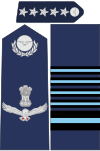
|
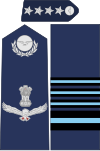
|
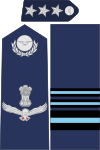
|
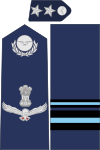
|
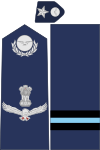
|

|

|

|

|

|
||||||||||||||||||||||||||

|

|

|

|

|

|

|

|

|

|

| ||||||||||||||||||||||||||
| Marshal of the Indian Air Force मार्शल ऑफ द इंडियन एयरफोर्स |
Air chief marshal एयर चीफ मार्शल |
Air marshal एयर मार्शल |
Air vice marshal एयर वाइस मार्शल |
Air commodore एयर कमोडोर |
Group captain ग्रुप कैप्टन |
Wing commander विंग कमांडर |
Squadron leader स्क्वाड्रन लीडर |
Flight lieutenant फ्लाइट लैफ्टिनेंट |
Flying officer फ्लाइंग अफसर |
Flight cadet फ्लाइट कैडेट | ||||||||||||||||||||||||||
Command flags

|

|

|

|

|

|

|
| MIAF | Air Chf Mshl | Air Mshl | AVM | Air Cdre | Gp Capt | Wg Cdr |
The IAF has ten commissioned officer (CO) ranks, of which the highest is that of Marshal of the Indian Air Force (MIAF), a ceremonial five-star rank.[5] The rank was awarded for the first, yet only time in January 2002 to then-retired Air Chief Marshal Arjan Singh DFC, who served as the IAF's third Chief of the Air Staff (CAS) between 1964 and 1969, for his exceptional leadership of the IAF during the 1965 Indo-Pakistan War.[5]
The highest operational rank in the IAF is the four-star rank of Air Chief Marshal, currently held exclusively by the CAS; coincidentally, the first time the rank was awarded was also to Singh in 1966, when he was then a Air Marshal.[6] Prior to him, CAS appointees belonged to the three-star rank of Air Marshal.[6]
Collar tabs
Sometime towards the end of Air Chief Marshal S. K. Sareen's tenure in 1998, the IAF introduced a new series gorget patches for its CO cadre - blue collar tabs embossed with white stars denoting the rank of the particular wearer; five for MIAF, four for Air Chief Marshal, three for Air Marshal, two for Air Vice Marshal and one for Air Commodore.[7] Initially, for the rank of Air Marshal, the collar tabs did not immediately distinguish between the positions of Vice Chief of the Air Staff (VCAS), Air Officer Commanding-in-Chief (AOC-in-C) and other three-star designated positions; however, later three-star collar tabs were embossed with a wreath design to solely indicate the positions of VCAS and AOC-in-C.[7]
Junior commissioned officer and non-commissioned ranks
The rank of Master Warrant Officer was introduced in February 1950.[8]
| Rank group | Junior commissioned officers | Non commissioned officer | Enlisted | |||||||||||||||||||||||||||||||||
|---|---|---|---|---|---|---|---|---|---|---|---|---|---|---|---|---|---|---|---|---|---|---|---|---|---|---|---|---|---|---|---|---|---|---|---|---|

|

|

|
No insignia | |||||||||||||||||||||||||||||||||
| Master warrant officer मास्टर वारंट अफसर |
Warrant officer वारंट अफसर |
Junior warrant officer जूनियर वारंट अफसर |
Sergeant सार्जेंट |
Corporal कॉरपोरल |
Leading aircraftsman लीडिंग एयरक्राफ्ट्समैन |
Aircraftsman एयरक्राफ्ट्समैन | ||||||||||||||||||||||||||||||
Former ranks
Effective from 16 May 1977, the rank of Flight Sergeant was abolished and replaced with the rank of Junior Warrant Officer; existing warrant officer rank insignia were modified accordingly.[10][11]
The rank of Pilot Officer is no longer in use; all new officers are commissioned as Flying Officers.
| Officers | Non-commissioned officers | ||||
|---|---|---|---|---|---|
| Shoulder Insignia |

|
Arm | 
|

|
|
| Rank | Pilot officer पायलट अफसर |
Warrant officer वारंट अफसर |
Junior warrant officer जूनियर वारंट अफसर |
Flight sergeant फ्लाइट सार्जेंट | |
See also
- Comparative military ranks
- Indian Army ranks and insignia
- Indian Navy ranks and insignia
- Coast Guard ranks and insignia of India
- Border Roads Organisation ranks and insignia of India
- Paramilitary forces ranks and insignia of India
- Police ranks and insignia of India
References
- ^ "Military Digest: As Indian Navy looks to introduce new ranks, a look at foreign origins of Naval ranks". The Indian Express. 16 October 2023.
- ^ a b c d "How India adopted its military flags and badges based on Lord Mountbatten's suggestions". optimizeias.com.
- ^ a b "New Designs of Crests and Badges in the Service" (PDF). 5 January 1950. Archived from the original (PDF) on 8 August 2017.
- ^ "For Officers". careerairforce.nic.in. Indian Air Force. Archived from the original on 25 February 2012. Retrieved 23 September 2021.
- ^ a b "Arjan Singh made IAF Marshal". The Tribune. 25 January 2002.
- ^ a b "India's First Marshal of the Air Force". archive.pib.gov.in. 25 January 2002.
- ^ a b "Uniforms, Badges and Other Regalia - Collar Tabs". www.bharat-rakshak.com. 30 November 1999.
- ^ "First Batch of IAF Master Warrant Officers" (PDF). Press Information Bureau of India - Archive. 14 February 1950. Retrieved 21 January 2024.
- ^ "For Airmen". careerairforce.nic.in. Indian Air Force. Archived from the original on 25 February 2012. Retrieved 23 September 2021.
- ^ "IAF officers badges". 15 May 1977. Archived from the original on 22 May 2022. Retrieved 23 September 2021.
- ^ "Flight Sergeants Become Junior Warrant Officers" (PDF). Press Information Bureau of India - Archive. 15 May 1977. Retrieved 21 January 2024.

